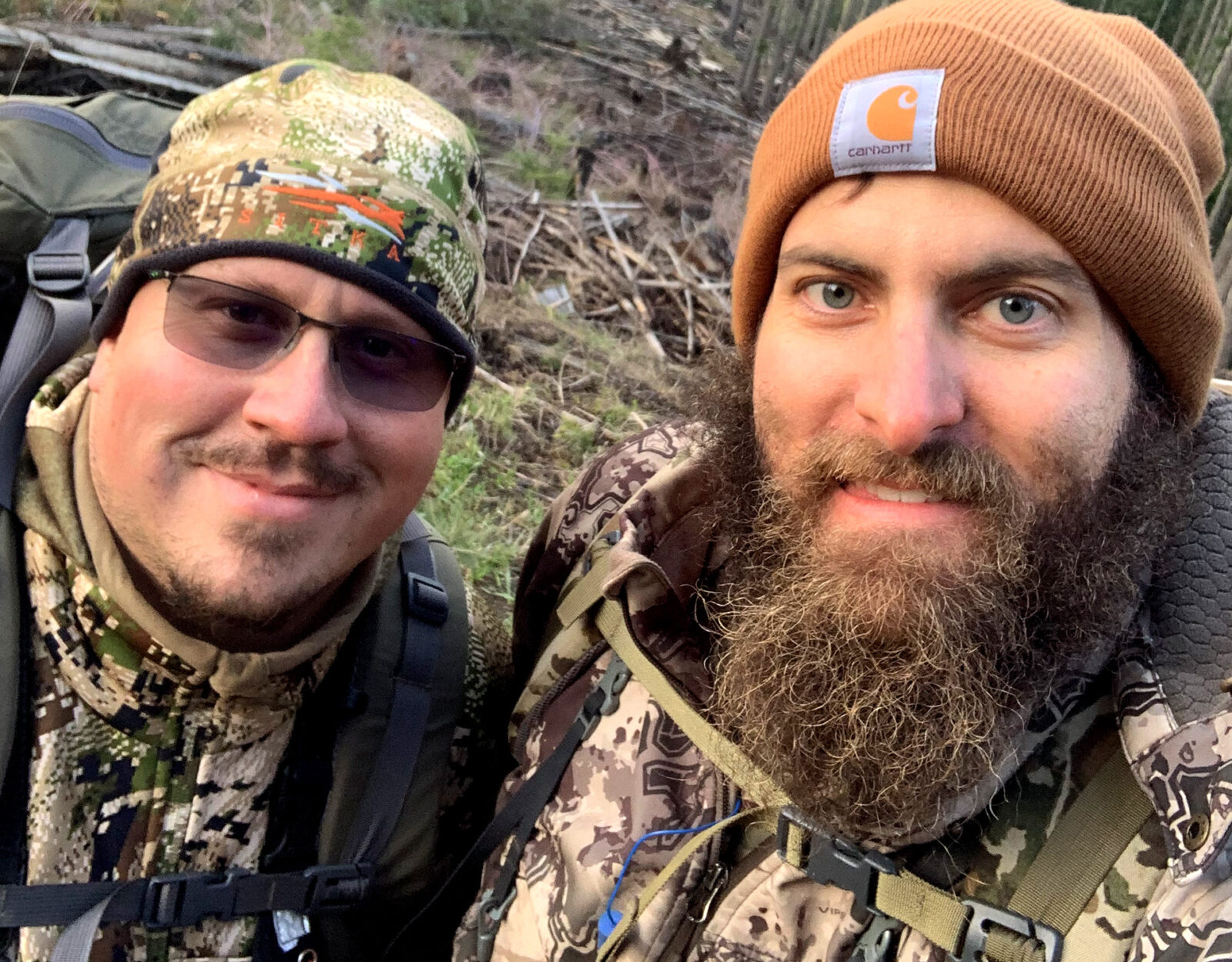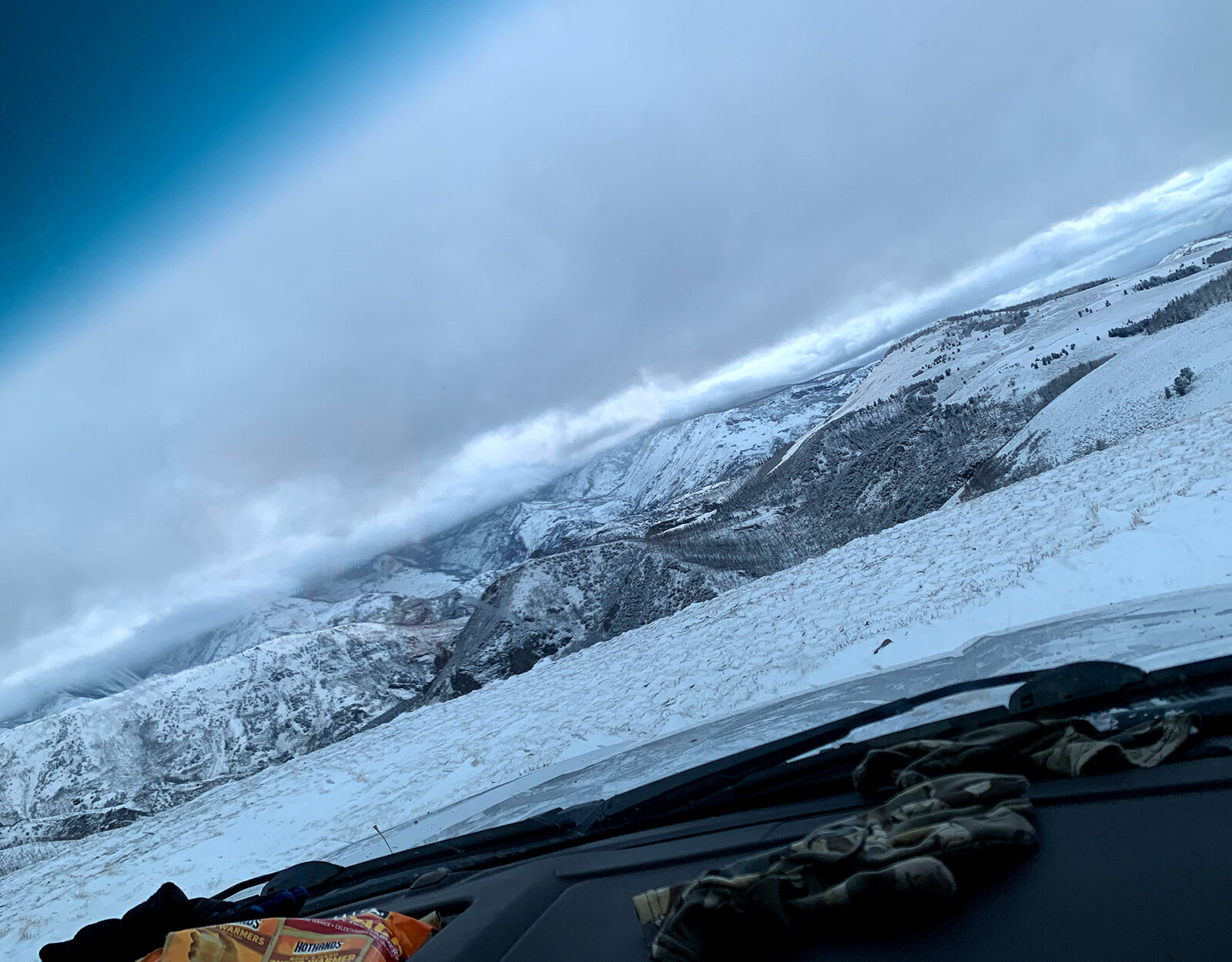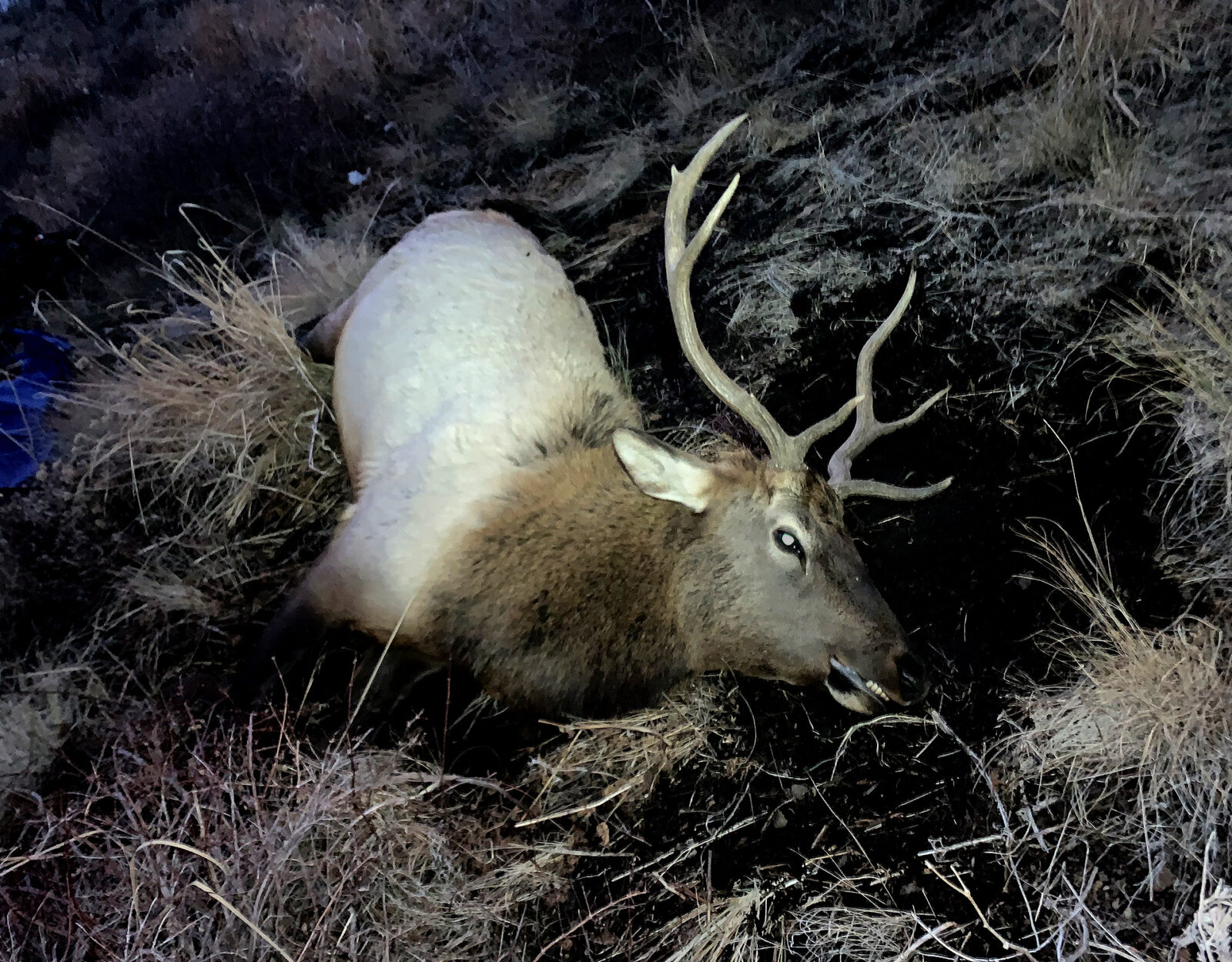It was only after his elk was down during a backcountry Nevada elk hunt that Matthew realized something was wrong. Caught in bad conditions far from the truck, he’d have to rely on his onX Hunt App Offline Maps to get him back to his friends, so he could then drive three hours to the nearest hospital.
When we heard Nevada hunter Matthew’s story, we had to have a chat. So we sat down with him to talk about hunting in Nevada, what went wrong in his elk hunt, what went right, and how the onX Hunt App helped him make it out safely.
onX: So tell me a bit about yourself. Where are you from, what’s the day job?
Matthew: I’m a born and raised third-generation Arizonan. I have a bachelor’s degree in microbiology from Arizona State University and a Doctorate of Pharmacy from the University of Arizona in Tucson. I currently live in Carson City, Nevada, and work as a pharmacy manager in Reno. I’m married with two young children.
Did you grow up hunting? How did you first get into hunting?
Unfortunately, I did not grow up hunting. After moving to northern Nevada, I was invited on a mule deer hunt with one of my new friends. We ended up harvesting a nice young buck on the last evening of the hunt, and after that I was officially hooked.
What is hunting in Nevada like? What do you enjoy/not enjoy about it? What are those opportunities for in-state, resident hunters?
I really like hunting in Nevada. The Nevada Department of Wildlife does a very good job managing herds that are healthy and growing. We have amazing elk hunting opportunities and the healthiest bighorn sheep population in the Lower 48. Nevada is a very large state with many different types of microclimates to hunt. You can hunt the low desert for bighorn sheep, the flats or low ranges for pronghorn, or 10,000-foot peaks for mule deer and elk.
I don’t enjoy that Nevada runs on a preference point draw system. They are somewhat unique in that they square your points for the number of entries, so the longer you apply, the better your odds get, but I would much rather have a random draw like New Mexico. I also don’t like that once you draw elk and pronghorn tags you must wait seven years for elk and four years for pronghorn before you can even apply again. You also cannot accumulate bonus points during this waiting period, and it doesn’t matter if you were successful during your drawn hunt, you still have to wait on the sidelines until those years pass. I understand that they want to give everyone a chance to hunt, but I think a random draw is a better way to do that.
We have many opportunities for in-state and out-of-state hunters, we have great fishing in our many streams and lakes, and great waterfowl/upland bird hunting for birds such as chukar and sage grouse. You can hunt mule deer, elk, pronghorn, black bear, three types of bighorn sheep, and even mountain goats.

So, this particular elk hunt sounds like a hell of a story. Walk us through what happened.
My elk hunt started with months of preparation, e-scouting, a physical scouting trip, and physical conditioning. It should have served as an omen when every person from my family was stricken with the stomach flu the week before the hunt. I arrived two days early with a full day of scouting set aside. This was the first time I had seen elk since I was a teenager in northern Arizona. I located a group of 40-50 elk with a seven-point herd bull, and eight or 10 satellite bulls all sparring up the hill about 100 yards. It was clear that there was a hot cow in the second estrus, and it was epic to watch them all day. I was several miles away on a ridge and planned a stalk to intercept them returning to their beds after a night of feeding with a full moon. That next day I hiked early—in the dark—but come sunrise, no elk. The next day the atmospheric river hit the mountains and changed everything.
After two days at lower elevations the snow finally melted enough that we could go back up to higher elevations, and this is when everything went to hell.
For four days this storm destroyed our hunting region, alternately dumping snow and rain so intense that we had to clear it every hour to prevent our tents and shade shelters from collapsing. No hunting was done; we were cold, wet, and depressed. Everyone had left the mountain except us and one other hunter in a large trailer. The fourth day we received a foot of snow in the first three hours of the day, so we decided for safety’s sake to pack camp and move down the mountain. The next two days were on and off rain and snow. We hunted at lower elevations since we couldn’t access higher elevations now they’d received well over two feet of snow. Besides mule deer and lots of mountain lion tracks, we encountered zero elk. After two days at lower elevations, the snow finally melted enough that we could go back up to higher elevations, and this is when everything went to hell.
From a glassing spot up on a hill my hunting partner spotted a bull elk and some cows. After locating them, they appeared to be in a meadow down the mountain through a draw, and to both of us appeared to be within a mile away. I slipped and slid down the mountain and utilizing my downloaded, offline onX maps, I mapped out my stalk. I had two hours of daylight left and was going to need every minute to get to them in time for legal shooting light.
After an hour and a half of fighting through thick aspen groves, deadfall, snow-covered rock slides, and streams I reached a knoll where I could get a range on them. I couldn’t believe it when they were still more than 1,000 yards away. What we couldn’t see was that the draw dropped off into a 30-degree, snow-covered slope with even more intense deadfall, thick trees, and horrible loose rock terrain. In the heat of the moment I decided it was worth the risk and I proceeded to continue my stalk.
Everything was like moving on ice. The melted snow made everything slick and my trekking poles saved me more times than I can count. On one occasion my boots fell through six inches of snow-covered tree deadfall into a small snow-melt stream hiding under the snow and wood. I had insulated boots, a waterproof rain outer layer, and high-quality wool socks so I kept on my stalk and wasn’t worried about it. After an hour I made it to a perfect spot down the draw.
I was testing the wind the entire time, and the thermals were changing from up the canyon to neutral and swirling, and I knew I was on borrowed time. A bull must have heard me or seen me because he immediately ran over to my direction from the meadow and up the hillside and stared in my direction for a few minutes. I ranged him, and he was 290 yards and at more than a 20-degree decline from my knoll to his hillside. I had 10 minutes of shooting light remaining, as he turned to leave he presented broadside and I knew I had my shot.
I said a prayer and took it.
Cold Realities
The bull raced like he was shot out of a cannon, went 50 yards, fell, tried to stand, then fell again and died. It was a miracle, and God delivered a perfect vitals shot. What I didn’t realize when I took the shot was that although the elk was 290 yards as the crow flies, it was another 1,000 yards of traversing more horrible terrain. I had planned ahead and arranged for an outfitter to pack the animal out on horses so I didn’t have an ethical problem taking the shot, but I also didn’t know I had made a potentially fatal survival mistake at that point.
After getting to the elk, I took a rest break and changed into spare dry clothes. It was then I noticed that I forgot to pack my merino base layer top and bottom in my pack (the only day of the entire hunt I forgot to do this), which was a huge mistake. It was now pitch black out, and I started field dressing my elk using the gutless method. The temperature dropped insanely fast and I had half of the elk field dressed when suddenly I lost nearly all motor function in my hands. I quickly realized that I was becoming hypothermic and after analyzing my body, realized that the inside of my boots were soaking wet and I couldn’t feel my feet.
What I didn’t realize was that during my stalk both of my waterproof outer pant legs had been torn to shreds at the bottom, and when I slipped on the deadfall and fell into the water, some water got into my boots and got my feet wet. It was so cold and wet out—and paired with the adrenaline from the stalk—I didn’t even notice this and my body was now shutting down. I removed my sock liners, wrung out my wool socks, and threw four hand warmers into each boot.

I knew that I had to get out and get moving to increase my body temperature, so I started the 1.5-mile ascent in the worst country I have ever faced in the pitch black darkness. I activated my emergency SOS function on my inReach device, and using onX on my phone I started the single worst hike of my life. I have never been more physically or mentally challenged like this… multiple times my mind kept telling me to lay down in the snow and go to sleep, which was terrifying.
Without onX I would have never gotten back to my car. I got misdirected and caught myself going the wrong direction at least five times, and this App definitely saved my life. Three grueling hours later I finally got back to my hunting partner and his son at the truck. I was out of water and could not stop shaking or form sentences. As a precaution, we raced to the nearest town three hours away in Idaho, where I went to the emergency room and was diagnosed with dehydration and extreme cold exposure. After leaving the ER at 3:30 AM, we had a quick night at a hotel and then raced back to our hunting camp. We loaded our packs and started the hike down to where I had field-dressed half of my bull elk.
The next possible limitation I’d overlooked was that my hunting partner had his nine-year-old son with him. This kid was incredible; he never complained and traversed this forsaken landscape like a spider monkey.
It took more than two hours to get to my elk. My hunting partner and I both agreed that the last 1,000 feet were too dangerous for his son, and since my body was beaten to hell I offered to stay with him because I wasn’t sure I would make it out if I attempted that last most treacherous part. My partner went down and did about an hour of work on the elk, and then we began the two-hour climb out of the canyon.

At this stage in my hunting career, I am solely a meat hunter, and this is the first animal I was unable to fully dress and pack out, so it really upset me down to my core that some of this animal was going to go to waste. The next day it took the outfitters six or seven hours on horses to reach and pack out my elk on four horses. (I had shot my elk on Wednesday night, but the ranchers were not available until Friday morning due to the snow and the accessibility of the roads.)
We were able to salvage all four quarters and the backstraps but lost the other meat (although we lost one quarter to spoilage once we got it to the butcher and inspected it). I am grateful that we were able to recover most of the meat, but regret that we lost any because it goes against my morals as a meat hunter.
How did the onX Hunt App figure into how things played out?
Without my downloaded onX Offline Maps, I would have been found several days later—still on that mountainside—by search and rescue. I got completely turned around several times and was heading in the completely wrong direction. Using the Tracker feature I was able to follow my tracks back out. Even in my compromised state of mind, I was able to get out. When you are completely in pitch black, land navigation in bad terrain becomes nearly impossible; you cannot safely navigate a wilderness area on foot without these detailed downloaded maps.
When you are completely in pitch black, land navigation in bad terrain becomes nearly impossible; you cannot safely navigate a wilderness area on foot without these detailed downloaded maps.
What’s next on your hunt list?
Next up is my first out-of-state and first over-the-counter elk hunt in Idaho, followed by a mule deer hunt in northeast Nevada. I am very excited for these hunts since they will also be my first-ever backpacking hunts as well.
What’s your bucket list hunt?
My bucket list hunt is hunting mountain goats in Alaska. Between the most beautiful scenic wilderness/wildlife and grueling challenge of pursuing such a beautiful animal, it would be an experience of a lifetime.
If you could give someone one piece of advice going into their first hunt, what would you say?
Know your limitations. It’s easy to overestimate your abilities based on the vast amount of knowledge available on the internet to a new hunter. Know when to quit when a hunt becomes unsafe, no animal is worth hunting if your life is potentially in danger. And finally have fun—we are so blessed to be able to do the things we love.